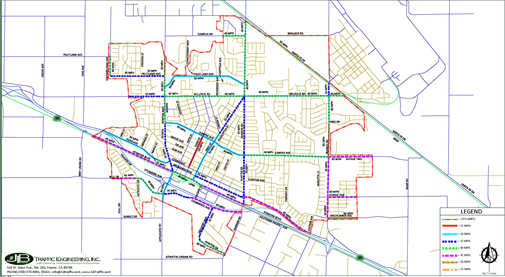
City of Atwater
JLB Traffic Engineering, (JLB) was retained by the City of Atwater to prepare a Citywide Engineering and Traffic Survey. The various engineering and traffic surveys were prepared pursuant to the latest editions of the California Manual on Uniform Traffic Control Devices (CA MUTCD) and the California Vehicle Code (CVC). JLB’s main objective for this project was to prepare a Citywide Engineering and Traffic Survey and recommend the appropriate speed limits consistent with the laws and practices of the State of California.
Engineering and traffic surveys were completed for 52 roadway segments consisting of radar speed surveys, daily traffic counts, collision data and an analysis of roadway conditions. The purpose of these surveys was to recommend the speed limits appropriate for enforcement and to provide any recommended speed limit changes in accordance with current State of California regulations and guidelines. Speed limits were established at, or near, the 85th percentile speed primarily to protect the public from the unreasonable behavior of reckless, unreliable, or dangerous drivers.
The 85th percentile speed, also referred to as the critical speed, is defined as the speed at or below which 85 percent of traffic is moving in free flow conditions. Speed limits established on this basis conform to the consensus of those who drive on the roadways as to what speed is reasonable and safe under normal driving conditions. The current standard, as described in the CA MUTCD is to consider the speed limit at
the nearest five miles per hour (mph) increment of the critical speed; however, a reduction of five mph is allowable to meet the needs of the community if justification is provided in accordance with the CVC through an engineering and traffic survey. Significant factors in determining reasonable and safe speed limits that are most appropriate to facilitate the orderly movement of traffic include prevailing speeds, collision rates, unexpected roadway conditions and adjacent land uses including residential and commercial densities.
Upon completion of the engineering and traffic surveys, JLB prepared an administrative draft report of the findings and recommendations and presented these to the City’s Community Development and Resources Commission for review and comment. Subsequently, JLB presented the findings to the City Council, who adopted the Citywide Engineering and Traffic Survey in 2015.